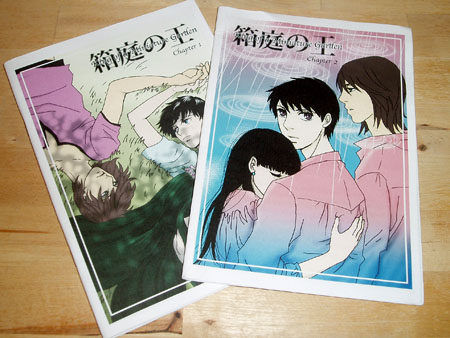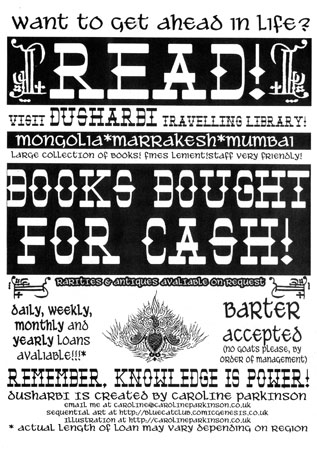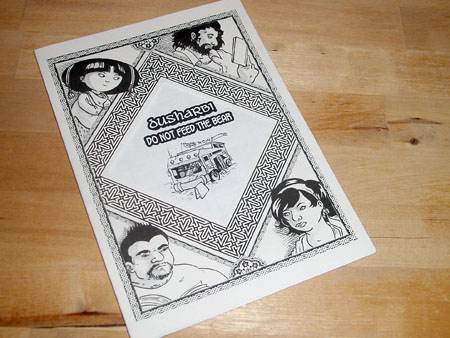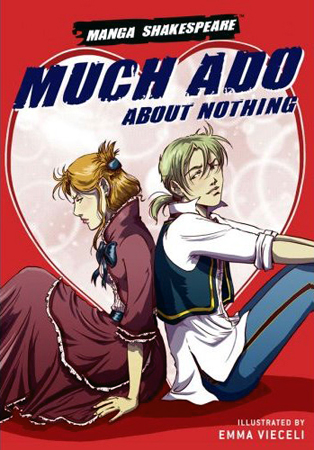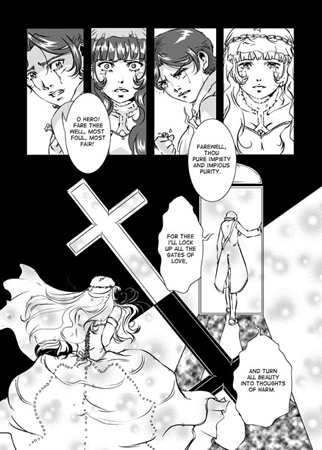‘Legends’ by IndieManga, 130 pages, A5, black and white with colour covers, £6
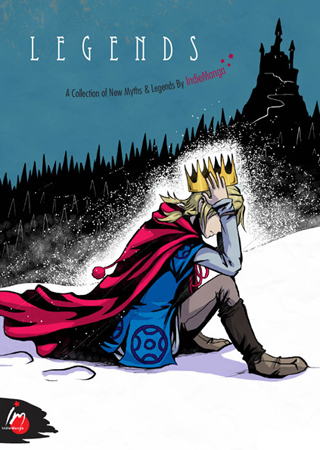
“What discerning eyes have you,
to notice here our humble book,
now there’s just one thing to do,
open it and have a look!” – Legends
And thus begins my adventure into Legends, the newest anthology from the comic circle IndieManga. This book contains five short comics revolving around the central theme of exploring fantastical tales, and in some cases their ties to the real world.
Every member of IndieManga is featured here: Kate Holden, who was one of the winners of this year’s Manga Jiman competition, Anna Fitzpatrick, who writes and draws Between Worlds, Sally Jane Thompson, who created Little Thoughts, Rebecca McCarthy, who’s writing also appeared in IndieManga’s first anthology ‘Origins’, and this time they introduce a new member in the form of Sarah Burgess, who also writes and draws the webcomic Far-Out-Mantic.
Below I’m going to give an example of a page from each comic in the anthology to show their different art styles, and also say a little about what I took away from the story in each short as well. First up is the 23-page Lucky, by Sarah Burgess:

Lucky is about a lowly squire who loses his pride and joy – his silver-haired horse – to some otherworldly thieves.
The story overall is well-paced, carrying the reader through the fantastical events with ease. The ending could possibly have used an extra page, just to slow it down and give it more impact, though it closes out with an interesting resonance to the real world. Similarly to her webcomic, Far-Out-Mantic, Sarah’s art for Lucky has a sketchy, emotions-first-accuracy-second, kind of feel to it. This means elements like her characters’ expressions and the organic flow of a lot of the pages, are practically perfect. However, some parts come across as rushed or even just anatomically wrong, which jerks the reader out of the story a little.
But what will bring you back in though is the hand-written text. Hand-drawn speech bubbles settle comfortably into the layout of each page, and parts where the text breaks free and takes your eyes all around the page as you read are really quite special.
Sharing Lucky’s page count of 23 is the next comic – Vitality, written by Rebecca McCarthy and drawn by Anna Fitzpatrick:

Apothecary shop assistant Bryther had been drinking a vitality elixir to keep herself going thorugh a day’s work, but when the shop gets demolished one day she gets a lesson in how much of a good thing might be too much.
Unfortunately I didn’t quite ‘get’ this story. It felt very much like it was trying to say something, but I’m still not entirely sure what that thing was. The plot begins in quite a slice-of-life way, focusing on the main character and her shop, but then introduces a lot of characters and big world events in quick succession. The reader does not really have enough time to digest all of this information before being taken back to a focus on the main character again for the ending. It seems like this story either needed to be much longer, with time given to introduce world events and the significance of these characters within them, or more stripped-down and simplified to fit into a shorter page count.
Art-wise, this comic has a painterly feel brought about by a use of flowing organic shapes to portray real human anatomy, rather than reducing the forms down to a more graphical style. Backgrounds are present and correct, and range from a riot of sketchy detail that can be hard to follow, to some wonderfully balanced and atmospheric scenes. It seems like some of the pages were a labour of love for the artist, and some were more rushed through. As a lover of small press endevours, I feel that the atmosphere brought out by the tighter, more considered, pages in Vitality makes this comic worth reading. However a more mainstream audience would probably expect the entire comic to be presented at this standard.
The impact of popular fantasy stories is considered in the next comic from the Legends anthology: A Walk – or a contemplation on fairy tales, viewpoints, creativity and growing up, by Sally Jane Thompson:

A Walk is 11 pages long. The story follows a young girl, who at the beginning is being read to before bed. As she hears the tale being read to her, a beanstalk begins to grow out of the book, and take her on a journey where she encounters lots of the stories and artistic styles that inspire her as she grows up.
These inspirations range from simple fairy tales to sparkly romance, into realism, and even some tinges of menace. As she interacts with each scene the girl visibly grows up, and at the end of the comic she clicks the lid back onto her pen as an adult artist.
This comic is obviously a very personal one that portrays several stories that have been inspirations or influences on the creator’s own development as an author and artist, perhaps also as a person.
Many different artistic styles and drawing media are used throughout this comic. The girl herself is always drawn with Sally’s trademark brushpen strokes, which both links her character to Sally as a person and brings all of the disparate art styles used in the comic together as one piece. As she takes her walk we pass panels drawn in a shojo (girl’s) manga style, simplified cartoons, patterns inspired by art nouveau, use of natural media, ink and screentones. Its a completely wordless comic, but you won’t miss the words at all.
Also making quite a sparing use of text is the next Legends entry: the 15 page 5 Finger Discount, by Anna Fitzpatrick:

In 5 Finger Discount, when a girl tries to steal a transformation potion from an old witch, an amazing transformations occurs…that could get her into a lot of trouble.
Stand out characters here are the old witch and the horrible blob monster you can see on the page above. They’re gloriously grotesque! The entire comic is of course drawn in Anna’s signature painterly style, but compared to Vitality, which she also drew, the screentones used here are of a larger scale (meaning that the dots are larger and further apart than the screentones used for Vitality). This means that some of the forms of the characters and backgrounds are a little bit less solid and more confusing to the eye, but it also gives the comic a lighter, more airy feel than Vitality, and thus its own personality.
The digital text used for the lettering in 5 Finger Discount is certainly very readable (which should be the first priority), but its also a little jarring over such natural-feeling artwork as Anna’s. On the other hand, the hand-written sound effects used here (such as the ‘wugableeugh!’ in the page above) are a real high point of the comic – perfectly legible throughout, balanced very nicely with the artwork on each page that they are used on, and suiting the unique personality of the story extremely well.
Showing yet another side to the personality of IndieManga as a group is the final entry in the Legends anthology, the 17 page Adventure, by Kate Holden:

At a foreboding castle in the desolate mountains, a group of three adventures goes toe-to-toe with an ancient foe and his army of automaton minions.
…did I mention the foe had epic flares?
The story and chracters in Kate Holden’s Adventure are pretty simple and archetypal: plucky heroine, brutish warrior, semi-naked elf…but the injection of Kate’s own personality makes it into a fun quirky parody piece. Her villain here is a good example: you can tell that he’s an epic foe right out of a fantasy story or RPG, but he also has a bit of a shonen (boy’s) fighting manga look to him. On top of this he wears a superhero-style mask, but forgoes the cape-and-tights for 60s style flares instead.
You might think that all of these influences would make for a bit of a muddled comic, but nothing could be further from the truth – its a very streamlined reading experience. The only thing holding it back is that, though the experience is fun, it is perhaps not quite hilarious enough as a parody comic to surmount the use of the very stereotypical characters and setting.
But setting aside,a high point to look out for throughout Adventure is the creator’s proficient use of solid blacks and whites in her artwork, giving a punchy, eye-catching finish. The only hiccup in the art is that, with such a structured style, it seems like buildings and interiors in the backgounds would need to be drawn with straighter, more confident, lines in order to make the best use of accurate perspective and have more impact alongside the characters.

Presentation:
Legends is a tidy and good-looking little book. Its perfect bound with black and white interior pages and full colour covers. The covers have a matte finish which gives a high quality look and feel to the book. A unifying, tongue-in-cheek, graphic design style throughout the book really brings the creators’ different styles together and makes this anthology into one cohesive volume.
The price was a bit hard to find as it wasn’t printed in big friendly numbers on the front cover like you get with a lot of comics. This may have been a conscious decision not to mar the cover design, and the price was mentioned in the blurb on the back, but something a little easier to spot would have been helpful.
If you enjoy UK manga, or dare I say it even small press comics in general, then I think you will find ‘Legends’ by IndieManga to be a rewarding pickup. As their name suggests, the group is inspired by manga, but certainly not a slave to stereotypical ‘manga’ art tropes. Barring some confusing sketchy pages pulling the reader a little out of the experience, overall I was struck by the unique personal creativity on show here – something that is hard to find in the mainstream, and I’m sure one of the reasons why us avid readers love the small press so much.
More books are available, including their first anthology ‘Origins’, on the IndieManga website.
Sarah Burgess has an ongoing webcomic, ‘Far-Out-Mantic’, and more of her work can be found on her portfolio website.
Kate Holden’s ongoing webcomic is Fan Dan Go, and she also has a portfolio website.
Sarah Jane Thompson also has a portfolio up online, plus an art blog.
Rebecca McCarthy has a website/blog.
Anna Fitzpatrick regularly updates her webcomic Between Worlds, as well as keeping a portfolio site and an art blog.
A review copy of this comic was provided.
